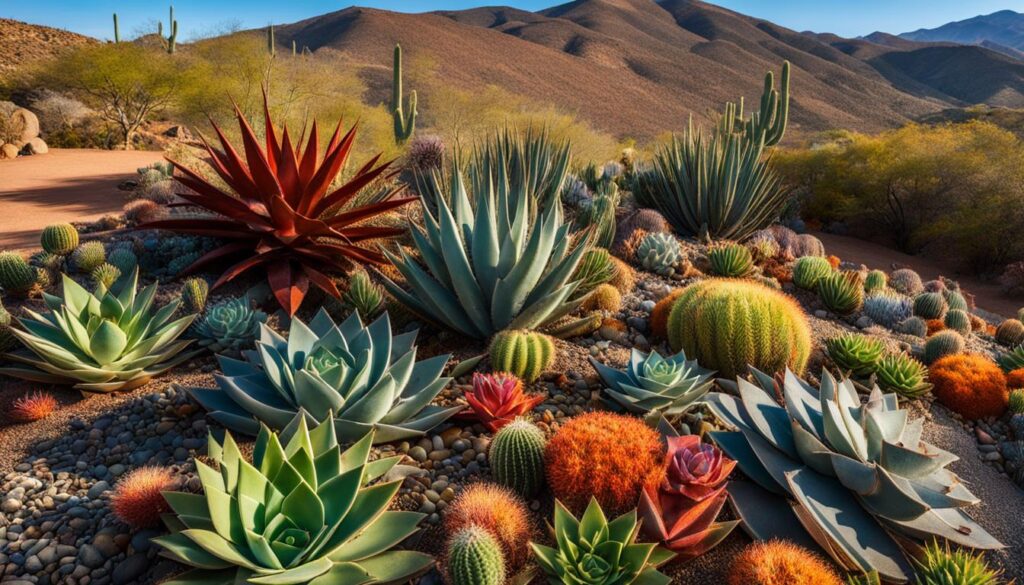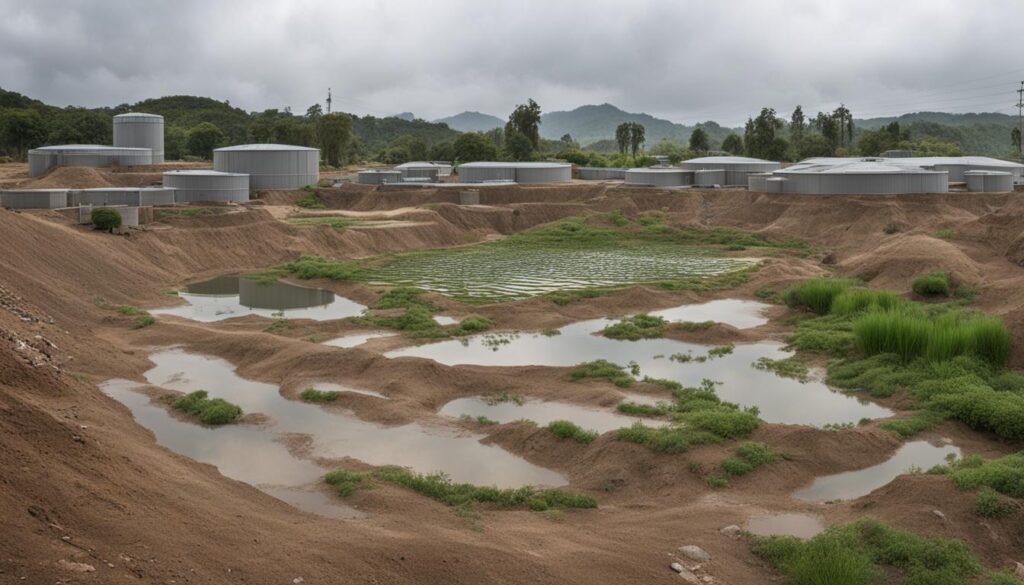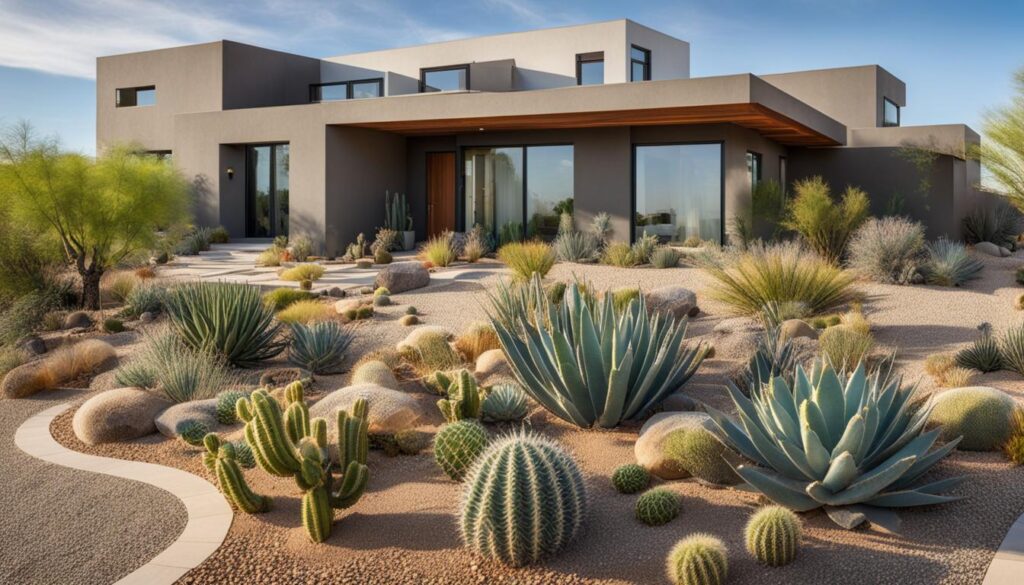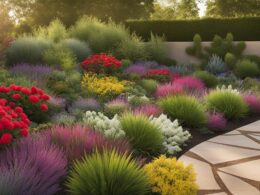Are you looking for a sustainable and water-efficient landscaping solution for your urban area? Look no further than xeriscaping! Xeriscaping is a smart approach to landscaping that focuses on water conservation while still creating a beautiful outdoor space. By implementing the principles of xeriscaping, you can transform your urban landscape into a thriving oasis while minimizing water usage.
Key Takeaways:
- Xeriscaping is a sustainable landscaping approach that promotes water conservation in urban areas.
- The principles of xeriscaping include water-wise planning and design, the use of low-water plants, limiting grass areas, water harvesting techniques, efficient irrigation systems, mulching, and proper maintenance.
- By implementing these principles, you can create a beautiful and eco-friendly landscape that reduces water consumption and maintenance efforts.
- Xeriscaping is not only beneficial for water conservation but also enhances the aesthetics of your outdoor space.
- Implementing xeriscaping principles can make a positive impact on the environment and promote sustainability in your urban area.
Water-wise Planning and Design
When it comes to xeriscaping, water-wise planning and design are essential for creating an efficient and sustainable landscape. By carefully analyzing your site and dividing it into different zones based on water needs, you can maximize water conservation while still enjoying a beautiful outdoor space.
The first step in water-wise planning and design is to create an Oasis area located close to your house. This area should have the highest water use and provide shade and aesthetics. It can include features such as a patio, seating area, or a small lawn. The middle zone of your property should be a transition area with moderate water needs, while the outer edge can be a low-water-use area that requires minimal or no irrigation once native plants are established.
Another important aspect of water-wise design is proper grouping of plants with similar water, sun, and maintenance needs. By grouping plants together, you can more efficiently water them and avoid wasted water. Additionally, incorporating hardscape elements such as rocks, gravel, or pathways can reduce the amount of irrigated area and create a visually appealing design.
Select and place plants wisely
“When planning your xeriscape design, choose plants that are well-adapted to your climate and soil conditions. Native plants are an excellent choice as they are naturally drought-tolerant and require minimal water once established.”
When selecting plants for your xeriscape, opt for low-water-use varieties that are adapted to your local climate and soil conditions. Native plants, in particular, are well-suited for xeriscaping as they are naturally drought-tolerant and require minimal water once they are established. Incorporating a variety of trees, shrubs, groundcovers, and wildflowers in your landscape can add texture, color, and visual interest while reducing water consumption.
By incorporating water-wise planning and design principles into your landscape, you can create a beautiful and sustainable outdoor space that conserves water and maintains the aesthetic appeal. The next section will delve into the importance of using low-water plants in xeriscaping.
Low-water Using Plants
One of the key principles of xeriscaping is the use of low-water plants. These plants are specifically chosen for their ability to thrive in arid conditions and require minimal irrigation. By incorporating low-water plants into your landscape design, you can create a beautiful and vibrant outdoor space while conserving water.
Drought-tolerant varieties and native plants are excellent options for xeriscaping. Drought-tolerant plants have adapted to survive with limited water resources, making them ideal for water-conscious landscaping. Native plants, on the other hand, are well-suited to the local climate and soil conditions, requiring less water and maintenance compared to non-native species.
When selecting low-water plants for your xeriscape, consider incorporating a variety of trees, shrubs, groundcovers, and wildflowers. This mix of plant types adds texture, color, and visual interest to your landscape. Additionally, grouping plants with similar water needs allows for more efficient irrigation, reducing water wastage and promoting healthy growth.
By choosing low-water plants for your xeriscape, you can create a sustainable landscape that not only conserves water but also enhances the beauty of your outdoor space. These plants not only require less irrigation but also contribute to the overall health of the ecosystem by attracting pollinators and supporting local wildlife.
Limit Grass Areas
Grass areas have long been a staple of traditional landscaping, but they require substantial amounts of water and maintenance to thrive. In a xeriscape, it is important to limit the use of grass to functional areas and consider alternatives in low-use areas. By reducing the amount of grass in your landscape, you not only conserve water but also create a more sustainable and low-maintenance outdoor space.
One popular alternative to traditional grass is the use of native grasses, which are well-adapted to the local climate and require less water and care. Native grasses, such as buffalo grass, can provide a lush and natural look while reducing water consumption. Additionally, drought-tolerant ground covers, like creeping thyme or sedum, can be used to replace grass in areas that are less frequently used.
By incorporating turf alternatives in your xeriscape, you can enjoy a beautiful and water-efficient landscape. These low-water options not only save you time and money on maintenance but also contribute to the overall sustainability of your outdoor space. So, consider reimagining your grass areas and explore the numerous alternatives available to create a xeriscape that is both visually appealing and environmentally friendly.
Turf Alternatives for Low-Use Areas
- Drought-tolerant ground covers like creeping thyme or sedum provide an attractive and low-maintenance option.
- Native grasses, such as buffalo grass, are well-adapted to the local climate and require less water.
- Moss can be a unique and eco-friendly alternative that thrives in shaded areas.
- Artificial turf can provide the look of grass without the need for watering or mowing, but it comes with some environmental considerations.
By exploring these turf alternatives and incorporating them into your xeriscape design, you can create a vibrant and water-wise landscape that enhances the beauty of your outdoor space while reducing your environmental impact.
Water Harvesting Techniques
Water harvesting techniques are integral to xeriscaping and play a crucial role in conserving water in urban areas. By implementing these techniques, you can make the most of rainfall and reduce reliance on irrigation. This not only contributes to water conservation but also helps create a more sustainable and environmentally friendly landscape.
One effective water harvesting technique is runoff redirection. By sloping sidewalks, terracing, or contouring lawns, you can steer rainwater towards planted areas instead of it being wasted as runoff. This ensures that the water reaches the roots of your plants where it is needed most.
“Water harvesting techniques involve redirecting runoff from rain to planted areas or collecting it for later use.”
Rainwater collection is another method commonly used in xeriscaping. By installing rain barrels or cisterns, you can capture and store rainwater for future use. This harvested water can then be used for watering plants during dry periods, reducing the need for additional irrigation.
In arid regions such as deserts, water harvesting has been practiced for centuries. Ancient civilizations like the Nabateans in Petra, Jordan, relied on cut-stone reservoirs to collect and store rainwater. Incorporating similar techniques, like creating rock “river” channels, can maximize water efficiency and contribute to desert water conservation.
Benefits of Water Harvesting Techniques:
- Maximizes rainwater utilization and reduces reliance on irrigation
- Conserves water resources and promotes sustainable landscaping
- Helps prevent runoff and erosion
- Reduces water bills and saves money in the long run
By incorporating water harvesting techniques into your xeriscape design, you can make a significant impact on water conservation and create a more sustainable outdoor space. These techniques not only help you save water but also contribute to the overall health of the environment.
Efficient Irrigation System and Design
An efficient irrigation system is a crucial component of a successful xeriscape. By utilizing the right irrigation methods and techniques, you can optimize water usage and promote water conservation in your landscape. Drip irrigation, for example, is a highly efficient method that delivers water directly to the root zone of individual plants, reducing evaporation and minimizing water waste. It is particularly effective for low-water plants and can significantly reduce overall water consumption.
In contrast, spray irrigation is more suitable for grass areas, ensuring even distribution of water. Bubbler and micro-spray systems, on the other hand, are ideal for shrubs and trees, providing targeted watering to their specific needs. By matching the irrigation method to the type of plant being watered, you can avoid water wastage and improve the overall efficiency of your irrigation system.
Schedule and Monitoring
Watering in the early morning and applying deep, widely spaced irrigations encourage deeper rooting and drought tolerance in plants.
Furthermore, it is essential to schedule and monitor your irrigation system effectively. Using a timer or controller allows for automated watering, ensuring consistency and avoiding overwatering. It is recommended to adjust irrigation schedules based on weather changes, as rainfall can provide natural irrigation and reduce the need for additional watering.
Grouping and Root Depth
Grouping plants with similar water needs together is another key aspect of efficient irrigation in xeriscaping. By understanding the water requirements of your plants and grouping them accordingly, you can avoid overwatering some areas while underwatering others. Additionally, considering root depth when planning your irrigation system ensures that water is delivered where it is most needed.
An efficient irrigation system not only conserves water but also promotes the long-term health and sustainability of your xeriscape. By implementing these strategies and practices, you can create a thriving and water-efficient landscape that contributes to a more sustainable future.
What Are the Basic Principles of Xeriscaping for Urban Areas?
Ecofriendly xeriscaping techniques promote water conservation and sustainable landscaping practices in urban areas. By incorporating drought-tolerant plants, efficient irrigation systems, and proper soil management, xeriscaping minimizes water usage while maintaining a beautiful and environmentally conscious outdoor space.
Conclusion
Xeriscaping is a sustainable and water-conserving approach to landscaping in urban areas. By following the seven principles of water-wise planning and design, using low-water plants, limiting grass areas, incorporating water harvesting techniques, installing efficient irrigation systems, mulching, and practicing proper maintenance, you can create a beautiful and eco-friendly landscape.
Xeriscaping not only helps conserve water but also enhances the aesthetics of your outdoor space and reduces maintenance efforts. By implementing these principles, you can make a positive impact on the environment and promote sustainability in your community.
So, start embracing the principles of xeriscaping in your urban landscape today. Create a landscape that not only conserves water but also showcases the beauty of low-water plants and incorporates innovative water harvesting techniques. Together, let’s contribute to a more sustainable and resilient future through the practice of xeriscaping.













